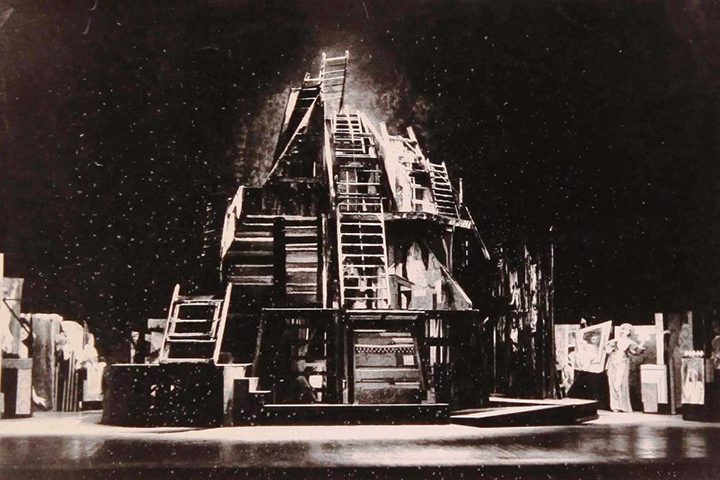Debutto: Roma, Teatro Argentina, 21 dicembre 1976
| Traduzione | Luigi Squarzina |
| Regia | Luigi Squarzina |
| Registi assistenti | Gianni Fenzi Angelo Corti Lorenza Codignola |
| Aiuto regista | Mario Rellini |
| Scene e costumi | Emanuele Luzzati |
| Musiche | Benedetto Ghiglia |
| Produzione | Teatro di Roma |
Personaggi e interpreti
| Vincenzo, duca di Vienna | Luigi Vannucchi |
| Angelo, vicario | Gabriele Lavia |
| Escalo, nobile anziano | Tino Bianchi |
| Claudio, giovane gentiluomo | Claudio Puglisi |
| Lucio, fantastico | Mario Scaccia |
| 1° gentiluomo | Edoardo Sala |
| 2° gentiluomo | Lorenzo Moncelsi |
| 3° gentiluomo | Gianni Williams |
| Il Bargello | SebastianoTringali |
| Frate Pietro | Pino Sansotta |
| Gomito, guardia | Ettore Conti |
| Schiuma, cliente di bordelli | Alberto Sorrentino |
| Pompeo, servo di madama Strafotta, clown | Gianni Fenzi |
| Abominevole, boia | Franco Calogero |
| Bernardino, galeotto | Franco D’Amato |
| Un giudice | Romolo Barbona |
| Un carceriere | Roberto Longo |
| Isabella, sorella di Claudio | Ottavia Piccolo |
| Giulietta, fidanzata di Claudio | Francesca Muzio |
| Marianna, fidanzata di Angelo | Rosa Maria Tavolucci |
| Francesca, monaca | Patrizia Sacchi |
| Madama Strafotta, ruffiana | Jole Silvani |
| Un bambino che canta | Antonio Valenti |
| Guardie | Enzo Benelli Enzo Provenzano Mario Rellini Massimo Rinaldi |
Squarzina ne ha allestito ben tre edizioni, nel 1957, nel 1976 e nel 1980, secondo differenti letture. Fin dalla prima edizione ne ha curato la traduzione, considerata pregevole e teatralmente valida, moderna e brillante.
Nella prima edizione Squarzina legge nella commedia scespiriana l’ipocrisia della censura, allora vigente, con una regia leggera e gradevole, aderente allo spirito del dramma, sobria e nitida, organica ed elegante, che rendeva un grande omaggio alla cultura.
Nella seconda edizione colloca la messinscena nella sua dimensione culturale e storica, rendendo Shakespeare nostro contemporaneo; vi legge, infatti, “i temi dell’ambiguità del potere, religioso, politico, giudiziario della città corrotta e ingovernabile che si deve comunque governare, dell’ordine e del disordine inestricabilmente mischiati”.
Per definire le motivazioni culturali e politiche e le connotazioni teatrali della commedia, nell’ambito del teatro elisabettiano e cogliere i possibili nessi con le nostre problematiche degli anni Settanta del Novecento, correda la messinscena di lezioni universitarie, dedicando a Shakespeare, nel 1976-77, un corso monografico. Quindi Squarzina accompagna le felici repliche nei teatri italiani di Misura per misura con il saggio “Le strutture del teatro elisabettiano-giacobeo” (1978).
La messinscena della seconda edizione e le considerazioni sviluppate nel corso monografico e nel saggio possono essere lette come riferimenti alla nostra storia nazionale dell’ultimo quarto del secolo scorso. E questo è il pregio fondamentale della lettura innovativa di Squarzina di un grande classico: il multiforme sopruso del potere, l’ipocrisia della virtù e della purezza, il disfacimento dei valori e la confusione dei linguaggi morali, l’iniquità mascherata di giustizia.
La messinscena, pur con l’indicazione precisa dei nessi con la storia politica, sociale e culturale dell’Inghilterra, è proiettata verso il nostro tempo tanto che “lo Shakespeare di Squarzina diventa contemporaneo… attraverso una lettura tanto umile quanto penetrante, fatta, però, con vigile coscienza di uomo moderno”, una scavata lettura frontalmente d’attualità, tutta civile, (politica quindi, ma non politicizzata)”.
La terza edizione è preceduta dal saggio “Brecht e gli elisabettiani” (1979) in cui propone il confronto tra “Teste tonde e teste a punta” di Brecht e il testo scespiriano, fonte primaria della commedia di Brecht, progettandone la contemporanea messinscena non realizzata per problemi di diritti d’autore. In questa edizione, “sulle tortuosità ideologiche e sull’interplay dei personaggi principali non potevano non pesare, data la misteriosa virtù di sismografo del testo, i tre anni che dal ’76 al ’79 ci hanno sconvolto… anni in capo ai quali il potere è riuscito a riproporre sfacciatamente se stesso, aiutato proprio dal «terrore» che rafforzava di fatto il dominio che dichiarava di voler scalzare”.
Dunque, ancora una volta, Shakespeare nostro contemporaneo.
Si ringrazia il teatro di Roma per la concessione dell’utilizzo del materiale fotografico.

